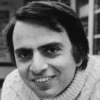Carl Sagan

Carl Sagan
Carl Edward Saganwas an American astronomer, cosmologist, astrophysicist, astrobiologist, author, science popularizer, and science communicator in astronomy and other natural sciences. He is best known for his contributions to the scientific research of extraterrestrial life, including experimental demonstration of the production of amino acids from basic chemicals by radiation. Sagan assembled the first physical messages sent into space: the Pioneer plaque and the Voyager Golden Record, universal messages that could potentially be understood by any extraterrestrial intelligence that might find...
NationalityAmerican
ProfessionScientist
Date of Birth9 November 1934
CityBrooklyn, NY
CountryUnited States of America
If we are not able to ask skeptical questions, to interrogate those who tell us that something is true, to be skeptical of those in authority, then, we are up for grabs for the next charlatan (political or religious) who comes rambling along.
Quickly capping 363 oil well fires in a war zone is impossible. The fires would burn out of control until they put themselves out... The resulting soot might well stretch over all of South Asia... It could be carried around the world... [and] the consequences could be dire. Beneath such a pall sunlight would be dimmed, temperatures lowered and droughts more frequent. Spring and summer frosts may be expected... This endangerment of the food supplies... appears to be likely enough that it should affect the war plans...
Philosophers and scientists confidently offer up traits said to be uniquely human, and the monkeys and apes casually knock them down -- toppling the pretension that humans constitute some sort of biological aristocracy among the beings on Earth.
My long-time view about Christianity is that it represents an amalgam of two seemingly immiscible parts-the religion of Jesus and the religion of Paul. Thomas Jefferson attempted to excise the Pauline parts of the New Testament. There wasn't much left when he was done, but it was an inspiring document.
Ask courageous questions. Do not be satisfied with superficial answers. Be open to wonder and at the same time subject all claims to knowledge, without exception, to intense skeptical scrutiny. Be aware of human fallibility. Cherish your species and your planet.
When a honeybee dies it releases a death pheromone, a characteristic odour that signals the survivors to remove it from the hive. The corpse is promptly pushed and tugged out of the hive. The death pheromone is oleic acid. What happens if a live bee is dabbed with a drop of oleic acid? Then no matter how strapping and vigourous it might be, it is carried kicking and screaming out of the hive.
We can't help it. Life looks for life.
Perhaps, in retrospect, there would be little motivation even for malevolent extraterrestrials to attack the Earth; perhaps, after a preliminary survey, they might decide it is more expedient just to be patient for a little while and wait for us to self-destruct.
You could just as well say that an agnostic is a deeply religious person with at least a rudimentary knowledge of human fallibility.
The fossil record implies trial and error, the inability to anticipate the future, features inconsistent with a Great Designer (though not a Designer of a more remote and indirect temperament.)
And after we returned to the savannahs and abandoned the trees, did we long for those great graceful leaps and ecstatic moments of weightlessness in the shafts of sunlight of the forest roof?
I can find in my undergraduate classes, bright students who do not know that the stars rise and set at night, or even that the Sun is a star.
In exchange for freedom of inquiry, scientists are obliged to explain their work.
The reappearance of the crescent moon after the new moon; the return of the Sun after a total eclipse, the rising of the Sun in the morning after its troublesome absence at night were noted by people around the world; these phenomena spoke to our ancestors of the possibility of surviving death. Up there in the skies was also a metaphor of immortality.